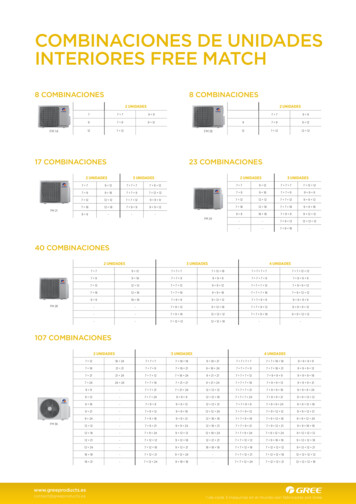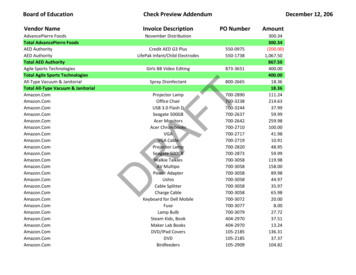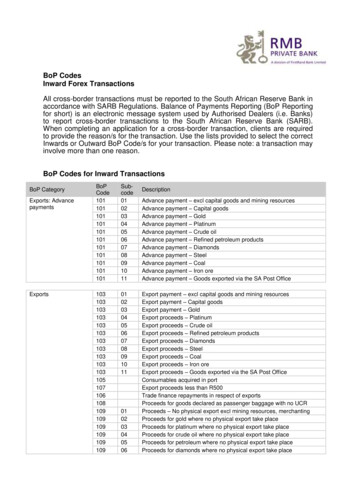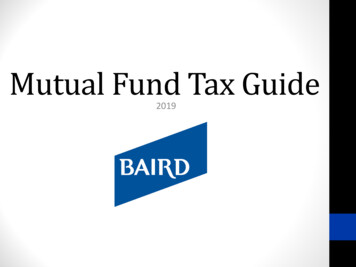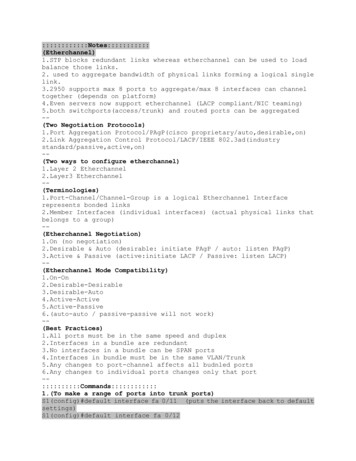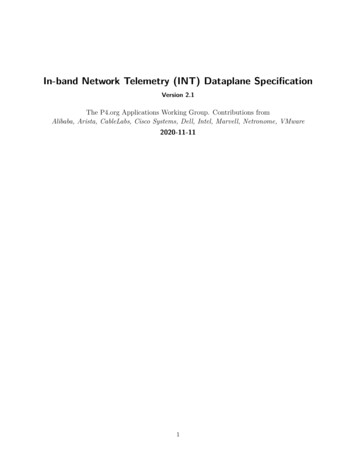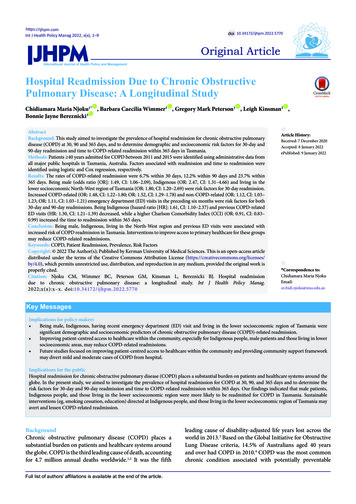
Transcription
https://ijhpm.comInt J Health Policy Manag 2022, x(x), 1–9doi 10.34172/ijhpm.2022.5770Original ArticleHospital Readmission Due to Chronic ObstructivePulmonary Disease: A Longitudinal StudyIDIDIDIDChidiamara Maria Njoku1* , Barbara Caecilia Wimmer1 , Gregory Mark Peterson1 , Leigh Kinsman2 ,IDBonnie Jayne Bereznicki3AbstractBackground: This study aimed to investigate the prevalence of hospital readmission for chronic obstructive pulmonarydisease (COPD) at 30, 90 and 365 days, and to determine demographic and socioeconomic risk factors for 30-day and90-day readmission and time to COPD-related readmission within 365 days in Tasmania.Methods: Patients 40 years admitted for COPD between 2011 and 2015 were identified using administrative data fromall major public hospitals in Tasmania, Australia. Factors associated with readmission and time to readmission wereidentified using logistic and Cox regression, respectively.Results: The rates of COPD-related readmission were 6.7% within 30 days, 12.2% within 90 days and 23.7% within365 days. Being male (odds ratio [OR]: 1.49, CI: 1.06–2.09), Indigenous (OR: 2.47, CI: 1.31–4.66) and living in thelower socioeconomic North-West region of Tasmania (OR: 1.80, CI: 1.20–2.69) were risk factors for 30-day readmission.Increased COPD-related (OR: 1.48, CI: 1.22–1.80; OR: 1.52, CI: 1.29–1.78) and non-COPD-related (OR: 1.12, CI: 1.03–1.23; OR: 1.11, CI: 1.03–1.21) emergency department (ED) visits in the preceding six months were risk factors for both30-day and 90-day readmissions. Being Indigenous (hazard ratio [HR]: 1.61, CI: 1.10–2.37) and previous COPD-relatedED visits (HR: 1.30, CI: 1.21–1.39) decreased, while a higher Charlson Comorbidity Index (CCI) (OR: 0.91, CI: 0.83–0.99) increased the time to readmission within 365 days.Conclusion: Being male, Indigenous, living in the North-West region and previous ED visits were associated withincreased risk of COPD readmission in Tasmania. Interventions to improve access to primary healthcare for these groupsmay reduce COPD-related readmissions.Keywords: COPD, Patient Readmission, Prevalence, Risk FactorsCopyright: 2022 The Author(s); Published by Kerman University of Medical Sciences. This is an open-access articledistributed under the terms of the Creative Commons Attribution License (https://creativecommons.org/licenses/by/4.0), which permits unrestricted use, distribution, and reproduction in any medium, provided the original work isproperly cited.Citation: Njoku CM, Wimmer BC, Peterson GM, Kinsman L, Bereznicki BJ. Hospital readmissiondue to chronic obstructive pulmonary disease: a longitudinal study. Int J Health Policy 2.5770Article History:Received: 7 December 2020Accepted: 8 January 2022ePublished: 9 January 2022*Correspondence to:Chidiamara Maria NjokuEmail:srchidi.njoku@utas.edu.auKey MessagesImplications for policy makers Being male, Indigenous, having recent emergency department (ED) visit and living in the lower socioeconomic region of Tasmania weresignificant demographic and socioeconomic predictors of chronic obstructive pulmonary disease (COPD)-related readmission. Improving patient-centred access to healthcare within the community, especially for Indigenous people, male patients and those living in lowersocioeconomic areas, may reduce COPD-related readmissions. Future studies focused on improving patient-centred access to healthcare within the community and providing community support frameworkmay divert mild and moderate cases of COPD from hospital.Implications for the publicHospital readmission for chronic obstructive pulmonary disease (COPD) places a substantial burden on patients and healthcare systems around theglobe. In the present study, we aimed to investigate the prevalence of hospital readmission for COPD at 30, 90, and 365 days and to determine therisk factors for 30-day and 90-day readmission and time to COPD-related readmission within 365 days. Our findings indicated that male patients,Indigenous people, and those living in the lower socioeconomic region were more likely to be readmitted for COPD in Tasmania. Sustainableinterventions (eg, smoking cessation, education) directed at Indigenous people, and those living in the lower socioeconomic region of Tasmania mayavert and lessen COPD-related readmission.BackgroundChronic obstructive pulmonary disease (COPD) places asubstantial burden on patients and healthcare systems aroundthe globe. COPD is the third leading cause of death, accountingfor 4.7 million annual deaths worldwide.1,2 It was the fifthFull list of authors’ affiliations is available at the end of the article.leading cause of disability-adjusted life years lost across theworld in 2013.3 Based on the Global Initiative for ObstructiveLung Disease criteria, 14.5% of Australians aged 40 yearsand over had COPD in 2010.4 COPD was the most commonchronic condition associated with potentially preventable
Njoku et alhospitalisation in four of the eight states and territories ofAustralia in 2015-2016.5 Tasmania is the only Australianisland state, with a population of 530 000,6 predominantlyregional and rural.7 In Tasmania, COPD was the third leadingcause of potentially preventable hospitalisation in 2015-2016,with 218 admissions per 100 000 population, which increasedby 9.0% in 2016-2017.8Previous research from the United States showed that 20%of patients admitted with an exacerbation of COPD werereadmitted within 30 days,9 and 50.0% were readmittedwithin six months10 of hospital discharge. A recent systematicreview highlighted inconsistencies across several risk factorspreviously reported as being associated with readmissionfor COPD.11 This review demonstrated that hospitalisationin the previous year was the key predictor of readmission.11Patients living in deprived areas and in nursing homes werealso at increased risk of readmission for COPD. However,there were variations in the reported factors associated withrisk of readmission, which may reflect differences in thelocal context, such as the availability of community-basedservices to prevent and care for exacerbation of COPD.It was recommended that risk factors for COPD-relatedreadmissions should be considered in the light of locality dueto variations in healthcare systems around the world.11A few Australian studies have addressed risk factors for allcause readmission following a COPD index admission,12,13but none have explored how patient characteristics relateto readmissions specifically for COPD. As an island state,Tasmania has minimal interstate hospital visits for patientsin the community, making it an ideal setting for longitudinalresearch. This study aimed to measure the prevalence of 30-day,90-day and 365-day COPD-related readmission in Tasmania.Additional aims were to identify the risk factors associatedwith 30-day and 90-day COPD-related readmission, and timeto readmission within 365-days.MethodsStudy Design and SettingIn this longitudinal study, a retrospective cohort of patientsadmitted with COPD to any of the four main public hospitalsin Tasmania between January 1, 2011 and December 31, 2015were reviewed. Data were collected until December 31, 2016,to allow 365 days follow-up for each patient. These hospitals(Royal Hobart Hospital, Launceston General Hospital, NorthWest Regional Hospital and Mersey Community Hospital)collectively account for 95% of all public hospital admissions.14The population of Tasmania is dispersed across three regions:Hobart (South; 271 214 persons), Launceston (North; 145 033persons) and the North-West Coast (111 954 persons), wherethese hospitals are located.6 Socioeconomic status acrossthe three regions varies. Within the socioeconomic rankingacross Australia, Southern Tasmania ranks among the highest,followed by the North, with the North-West ranking lowest.15Four percent of Tasmanian residents identfiy as Indigenous.16Data SourceThe study utilised the anonymised administrative admittedpatient care National Minimum Data Set from the2Department of Health and Human Services, Tasmania.The dataset provided access to de-identified demographic,administrative and clinical information pertaining to allCOPD-related admissions and readmissions from January1, 2011 to December 31, 2016. Mortality records of admittedpatients were linked to the dataset.Study ParticipantsThe study comprised patients aged 40 years and over, whohad an overnight hospitalisation with a primary diagnosisof COPD between January 1, 2011 and December 31, 2015(index admission). The diagnosis of COPD was determinedusing the International Statistical Classification of Diseasesand Related Health Problems, Tenth Revision, AustralianModification (ICD-10-AM) codes (J40–J44).MeasuresAll patients with an index admission were followed up for365 days post-index discharge, except in the case of deathoccurring first. COPD-related readmissions following theindex admission within 30, 90, and 365 days were analysedfor all patients. COPD-related readmissions were subsequentadmissions with a primary diagnosis of COPD. Nonreadmitted patients were those who had an index admissionbut did not have a subsequent COPD-related readmissionwithin the follow-up period. Those who died were identifiedfrom the mortality records that were linked to the dataset.Based on well-established evidence on the relationshipbetween previous emergency department (ED) visits andCOPD-related readmission, the numbers of COPD-relatedand non-COPD-related ED visits in the six months precedingthe index admission were both recorded as covariates.11Socioeconomic status of patients was estimated from theirresidential address using the Index of Relative Socio-economicAdvantage and Disadvantage (IRSAD) for areas.17 Based onthe Australian Bureau of Statistics recommendation, decileswere used in ranking the index of IRSAD.17 Patients’ usualresidence was also used to group participants into the threemain geographical regions (South, North and North-West)in Tasmania. Other covariates that were considered includedage at index admission, sex, country of birth (Australia oroverseas) and Indigenous status. Variables related to patients’index admission included discharge destination, admission tointensive care, length of stay, weekday or weekend admissionand season of admission. The Charlson Comorbidity Index(CCI) 18 was used to determine the level of comorbidity.Statistical AnalysisData were analysed using STATA version 16.1 (StataCorpLLC, College Station, TX, USA). Descriptive analyses wereused to report the prevalence of COPD-related readmission.Demographic and clinical characteristics of patients who wereand were not readmitted during the follow-up periods werecompared. Chi-square tests were used to compare categoricalvariables, and Mann-Whitney U-tests were used to comparecontinuous variables, between patients who were and werenot readmitted.Multiple logistic regression was performed to determineInternational Journal of Health Policy and Management, 2022, x(x), 1–9
Njoku et althe factors independently associated with 30-day and 90-dayreadmission. Based on previous studies,11 age and sex, togetherwith variables with P values of .10 in the univariate analyses,qualified for entry into the logistic regression models. Prior toperforming logistic regression, variables were tested for intercorrelation. Categorical variables were assessed for collinearityagainst continuous variables using the Mann-Whitney Utest and included in the logistic regression model if P .05.Continuous or ordinal variables were assessed for collinearityagainst other continuous variables using a correlation test andincluded if the Spearman rho 0.40.Cox proportional hazards regression was used to identifyindependent factors associated with time to first COPDreadmission within 365 days. Bivariate analyses (ie, simpleCox regression) were performed for each variable. Age,gender and variables with P values of .10 were included inthe multiple Cox proportional hazard regression. The endof follow-up was set at 365 days after hospital discharge ordate of death, whichever occurred first. Proportional hazardsassumption was assessed for each variable by visual inspectionof the log-minus-log plots across the covariate categories andby analysing residuals. Proportional hazard assumptions wereconfirmed using the test for parallel lines.ResultsPrevalence of COPD-Related Readmission in TasmaniaBetween January 1, 2011 and December 31, 2015, there were2448 patients 40 years who had an overnight index admissionwith COPD as the primary diagnosis and were followed up forsubsequent COPD-related readmissions (Table 1). The rate ofCOPD-related readmission was 6.7% within 30 days, 12.2%within 90 days and 23.7% within 365 days (Figure).Factors Associated With COPD-Related ReadmissionsTable 2 shows the factors associated with 30-day, 90-day and365-day readmissions. Six variables were included in the 30day and the 90-day readmission multivariate models (Table3). There was significant intercorrelation between Tasmanianregion and IRSAD deciles (Kruskal-Wallis H test χ2 106.68,P .0001), which resulted in the exclusion of IRSAD decilefrom the multivariate analyses.Being male (odds ratio [OR]: 1.49, 95% CI: 1.06–2.09),Indigenous (OR: 2.47, 95% CI: 1.31–4.66), living in theNorth-West region (OR: 1.80, 95% CI: 1.20–2.69), andincreased COPD-related (OR: 1.48, 95% CI: 1.22–1.80) andnon-COPD-related (OR: 1.12, 95% CI: 1.03–1.23) ED visitsin the previous six months were significant risk factors for30-day readmission. Increased COPD-related (OR: 1.52, 95%CI: 1.29–1.78) and non-COPD-related (OR: 1.11, 95% CI:1.03–1.21) ED visits in the previous six months significantlyincreased the risk of 90-day readmission. The most commonreasons for non-COPD related ED visits were pneumonia(1614/15 421; 10.5%), pain in the throat and chest (881/15 421;5.7%) and heart failure (714/15 421; 4.6%).Independent Predictors of Shorter Time to ReadmissionThe median time to the first COPD-related hospitalreadmission within 365 days was 75 days (interquartilerange [IQR] 59–84). Seven variables were included in themultivariate Cox proportional hazard regression analysis(Table 4). Being Indigenous (median time to readmission59 days [IQR 10–75], hazard ratio [HR]: 1.61, 95% CI: 1.10–2.37) and a higher number of COPD-related ED visits in theprevious six months (median time to readmission 68 days[IQR 24–85], HR: 1.30, 95% CI: 1.21–1.39) were associatedwith shorter time to readmission within 365 days, while ahigher CCI was associated with longer time to readmission(median time to readmission 81 days [IQR 39–165], HR: 0.91,95% CI: 0.83–0.99).DiscussionTo our knowledge, this is the first Australian study to assessrisk factors for COPD-related readmission. The rates ofCOPD-related readmission within 30 days (6.7%), 90 days(12.2%) and 365 days (23.7%) were comparable to thosereported in studies from other countries, such as the UnitedTable 1. Demographic and Admission Characteristics of All Patients WithChronic Obstructive Pulmonary Disease Index AdmissionCharacteristicsAge (y), median (IQR)Gender, No. (%)MaleFemaleCountry of birth, No. (%)Australian bornOverseas bornIndigenous status, No. (%)IndigenousNon-IndigenousMissing dataTasmanian region, No. (%)SouthNorthNorth-WestInterstate patientsIRSAD decileCCI, median (IQR)Length of index stay (days), median (IQR)Intensive care admission at index, No. (%)YesNoDischarge destination, No. (%)HomeNursing homeOtheraAdmission day of the week, No. (%)WeekendWeekdayAustralian season of admission, No. (%)SpringSummerAutumnWinterAll Patients (n 2448)72 (64–80)1222 (49.9)1226 (50.1)2150 (87.8)298 (12.2)97 (4.0)2340 (95.6)11 (0.4)991 (40.5)696 (28.4)724 (29.6)37 (1.5)3 (2–5)0 (0–1)3.9 (2.1–6.8)141 (5.8)2307 (94.2)2158 (88.2)50 (2.0)240 (9.8)638 (26.1)1810 (73.9)684 (27.9)489 (20.0)469 (19.2)806 (32.9)Abbreviations: IQR, interquartile range; CCI, Charlson Comorbidity Index;IRSAD, Index of Relative Socioeconomic Advantage and Disadvantage.aOther: welfare institutions, prisons, mental and rehabilitation centres,private and rural hospitals.International Journal of Health Policy and Management, 2022, x(x), 1–93
Njoku et alPatients with overnight index COPD admissionswithin 2011-2015 n 2,448Index discharge within 2011-2015Died at index admissionn 2,327 (95.1%)n 121 (4.9%)Eligible for 30-day readmissionDied within 30 days without readmissionn 2,261 (99.2%)n 66 (2.8%)ReadmittedNot Readmittedn 151 (6.7%)n 2,110 (93.3%)Eligible for 90-day readmissionDied within 90 days without readmissionn 2,206 (94.8%)n 121 (5.2%)ReadmittedNot Readmittedn 270 (12.2%)n 1,936 (87.8%)Eligible for 365 days readmissionDied within 365 days without readmissionn 2,009 (86.3%)n 318 (13%)ReadmittedNot Readmittedn 477 (23.7%)n 1,532 (76.3%)Figure. Prevalence Of 30-Day, 90-Day and 365-Day COPD Readmission in Tasmanian Public Hospitals. Abbreviation: COPD, chronic obstructive pulmonary disease.States,19 Spain20 and France.21 There are also studies thatreported lower22 or higher23 rates.Patients who were male, Indigenous and living in a lowersocieconomic region (North-West) were at significantlyincreased risk of 30-day COPD-related readmission. COPDrelated and non-COPD related ED visits in the previous sixmonths increased the risk of 30-day and 90-day readmission.Being Indigenous and having more COPD-related ED visitsin the past six months were associated with shorter time toreadmission, while higher CCI was related to longer time toreadmission within 365 days.Patients living in the North-West region of Tasmania were80% more likely to be readmitted within 30 days compared tothose living in the South. Several studies have demonstratedan increased risk of readmission for COPD among peopleliving in deprived areas.21,24 The North-West region isTasmania’s poorest region and, according to national data,people in lower socioeconomic areas are more likely to havepoorer health status, higher smoking rates, poorer access toprimary healthcare and are less able to pay for medication.16,25A UK study found that disadvantaged communities have lowratios of general practitioners (GPs) per 1000 population.26This finding is similar in Tasmania, with its lower number offull-time equivalent GPs in the North-West compared withSouthern Tasmania (64.2 vs 78.7 per 100 000 population,respectively in 2012).27 The disparity in provision and accessof primary healthcare services to the socioeconomicallydisadvantaged communities may explain their higherreadmission risk.Being Indigenous was the strongest risk factor for 30day readmission, and significantly decreased the time toreadmission within 365 days. National data indicate thatIndigenous Australians are about three times more likely4to be daily smokers, and have a 2.5 times higher prevalenceof COPD and five times higher rate of hospitalisation forCOPD. 28There have been conflicting results regarding theassociation of sex and COPD-related readmission in theliterature. Zapatero et al29 reported male patients were 25%less likely to be readmitted, another study found no suchassociation,30 while another demonstrated male patients were45% more likely to be readmitted within 30 days.31 We foundthat male patients were 49% more likely to be readmittedwithin 30 days. A potential reason for this observation inTasmania could be the higher rate of current male smokers(19.3%) compared to females (15.7%).32 There is also thepossibility of more men having higher occupational exposureto dust and fume chemicals.33 Male patients may also be lesslikely to seek health advice during illness.34 This could delaymanagement of mild/moderate symptoms before escalationto more severe symptoms requiring hospitalisation and thenrecurrent readmission.The numbers of COPD-related and non-COPD-relatedED visits in the six months prior to the index admission wereassociated with an increased risk of readmission within 30and 90 days, as well as a significantly shorter time to COPDreadmission. These findings are similar to prior studies thatfound a significant correlation between COPD readmissionand previous ED visits.24,30 One explanation points to patientswith a frequent exacerbation phenotype, who may be morelikely to be readmitted.35 Patients with severe COPD maybe more susceptible to frequent ED visits and admissions tohospital.19,36Frequent ED visits, leading to hoispital admission, place anenormous burden on patients and the healthcare system. Aprevious study in Tasmania reported a 2.5 times higher perInternational Journal of Health Policy and Management, 2022, x(x), 1–9
Njoku et alTable 2. Demographic and Admission Characteristics Based on Readmission StatusCharacteristicsVariables30-Day Readmission90-Day Readmission365-Day ReadmissionTotal (n 2261)Yes (n 151)No (n 2110)PTotal (n 2206)Yes (n 270)No (n 1936)PTotal (n 2009)Yes (n 477)No (n 1532)P72 (64–80)72 (64–79)72 (64–80).2872 (64–80)73 (65–80)72 (64–80).7671 (64–79)72 (64–79)71 (64–79).91Male1117 (49.4)89 (8.0)1028 (92.0).021083 (49.1)148 (13.7)935 (86.3)968 (48.2)238 (24.6)730 (75.4).39Female1144 (50.6)62 (5.4)1082 (94.6)1123 (50.9)122 (10.9)1001 (89.1)1041 (51.8)239 (23.0)802 (77.0)Australian born1989 (88.0)137 (6.9)1852 (93.1)1939 (87.9)235 (12.1)1704 (87.9)1768 (88.0)419 (23.7)1349 (76.3)Overseas born272 (12.0)14 (5.1)258 (94.9)267 (12.1)35 (13.1)232 (86.9)241 (12.0)58 (24.1)183 (75.9)89 (4.0)14 (15.7)75 (84.3)88 (4.0)16 (18.2)72 (81.8)82 (4.1)32 (39.0)50 (61.0)2161 (95.6)137 (6.3)2024 (93.7)2107 (95.5)253 (12.0)1854 (88.0)1917 (95.4)443 (23.1)1474 (76.9)821 (40.9)200 (24.4)621 (75.6)558 (28.2)126 (22.6)432 (77.4)597 (30.2)151 (25.3)446 (74.7)Age (y), median (IQR)Gender, n (%).05Country of birth, n (%).28.64.90Indigenous status, n (%)IndigenousNon-IndigenousMissing data .0111 (0.4).0811 (0.5) .0111 (0.5)Tasmanian region, n (%)South906 (40.1)48 (5.3)858 (94.7)North651 (28.8)42 (6.5)609 (93.5)North-West671 (29.7)61 (9.1)610 (90.9)Interstate patients.0133 (1.5)889 (40.9)108 (12.1)781 (87.9)625 (28.8)66 (10.6)559 (89.4)659 (30.3)96 (14.6)563 (85.4).0933 (1.5).5533 (1.6)IRSAD decile, median (IQR)3 (2–5)3 (2–4)3 (2–5).263 (2–5)3 (2–4)3 (2–5).023 (2–5)3 (2-4)3 (2–5).13CCI, median (IQR)1 (1–2)1 (1–2)1 (1–2).741 (1–2)1 (1–2)1 (1–2).380 (0–1)0 (0–1)0 (0–1).01Length of index stay (days), median (IQR)4 (2–7)4 (2–7)4 (2–7).654 (2–6)4 (2–7)4 (2–6).334 (2,6)4 (2,7)4 (2,6) .01Yes111 (4.9)5 (4.5)106 (95.5)109 (4.9)8 (7.3)101 (92.7)95 (4.7)21 (22.1)74 (77.9).70No2150 (95.1)146 (6.8)2004 (93.2)2097 (95.1)262 (12.5)1835 (87.5)1914 (95.3)456 (23.8)1458 (76.2)Intensive care admission at index, n (%).35.11International Journal of Health Policy and Management, 2022, x(x), 1–95
Njoku et alTable 2. ContinuedCharacteristicsVariables30-Day Readmission90-Day ReadmissionTotal (n 2261)Yes (n 151)No (n 2110)2043 (90.4)135 (6.6)1908 (93.4)Nursing home42 (1.9)3 (7.1)39 (92.9)Other176 (7.8)13 (7.4)163 (92.6)P365-Day ReadmissionTotal (n 2206)Yes (n 270)No (n 1936)1998 (90.6)246 (12.3)1752 (87.7)40 (1.8)4 (10.0)36 (90.0)168 (7.6)20 (11.9)148 (88.1)PTotal (n 2009)Yes (n 477)No (n 1532)1,832 (91.2)439 (24.0)1,393 (76.0)32 (1.6)4 (12.5)28 (87.5)145 (7.2)34 (23.4)111 (76.6)PDischarge destination, n (%)Homea.92.90.32Number of ED visits in previous 6 months, median (IQR)COPD-related1 (0–1)1 (0–1)1 (0–1) .011 (0–1)1 (0–1)1 (0–1) .011 (0,1)0 (0,1)0 (0,1) .01Non-COPD-related1 (0–1)1 (0–2)1 (0–1).021 (0–1)1 (0–2)1 (0–1).021 (0–1)1 (0–2)1 (0–1).02Weekend589 (26.1)38 (6.5)551 (93.5).80576 (26.1)68 (11.8)508 (88.2)522 (26.0)120 (23.0)402 (77.0).64Weekday1672 (73.9)113 (6.8)1559 (93.2)1630 (73.9)202 (12.4)1428 (87.6)1487 (74.0)357 (24.0)1130 (76.0)Spring620 (27.4)42 (6.8)578 (93.2)607 (27.5)70 (11.5)537 (88.5)557 (27.7)118 (21.2)439 (78.8)Summer453 (20.0)30 (6.6)423 (93.4)441 (20.0)49 (11.1)392 (88.9)389 (19.4)113 (29.0)276 (71.0)Autumn426 (18.8)27 (6.3)399 (93.7)415 (18.8)65 (15.7)350 (84.3)378 (18.8)88 (23.3)290 (76.7)Winter762 (33.7)52 (6.8)710 (93.3)743 (33.7)86 (11.6)657 (88.4)685 (34.1)158 (23.1)527 (76.9)Admission day of the week, n (%).71Australian season of admission, n (%).99.13Abbreviations: IQR, interquartile range; ED, emergency department; CCI, Charlson Comorbidity Index; IRSAD, Index of Relative Socioeconomic Advantage and Disadvantage.aOther: welfare institutions, prisons, mental and rehabilitation centres, private and rural hospitals.6International Journal of Health Policy and Management, 2022, x(x), 1–9.04
Njoku et alTable 3. Logistic Regress Ion for Predictors of COPD-Related Readmission Within 30 Days and 90 DaysVariables30-Day ReadmissionAdjusted OR (95% CI)90-Day ReadmissionAdjusted OR (95% CI)0.99 (0.98–1.01)1.49 (1.06–2.09)2.47 (1.31–4.66)1.00 (0.99–1.02)1.24 (0.95–1.61)1.52 (0.85–2.73)1.25 (0.81–1.92)1.80 (1.20–2.69)0.82 (0.59–1.14)1.21 (0.89–1.64)1.48 (1.22–1.80)1.12 (1.03–1.23)1.52 (1.29–1.78)1.11 (1.03–1.21)Age (y)Male (vs female)Indigenous (vs non-Indigenous)Tasmanian region (vs South)NorthNorth-WestNumber of ED visits in previous 6 monthsCOPD-relatedNon-COPD-relatedAbbreviations: OR, odd ratio; CI, confidence interval; ED, emergency department; COPD, chronic obstructive pulmonary disease.Table 4. Cox Proportional Hazards Regression for Factors Associated With Time to Readmission Within 365 DaysVariablesUnadjusted HR (95% CI)Adjusted HR (95% CI)Age (y)1.00 (0.99–1.01)1.00 (0.99–1.01)Male (vs female)1.05 (0.88–1.26)1.03 (0.86–1.24)Australian born (vs oversea born)0.99 (0.76–1.31)Indigenous (vs non-Indigenous)1.91 (1.34–2.74)1.61 (1.10–2.37)Tasmanian region (vs South)North0.88 (0.71–1.11)North-West1.04 (0.84–1.29)0.88 (0.81–0.96)0.91 (0.83–0.99)Spring0.91 (0.71–1.15)0.88 (0.69–1.11)Summer1.24 (0.97–1.58)1.12 (0.88–1.44)Autumn1.03 (0.79–1.33)1.02 (0.79–1.33)CCIAustralian season of admission (vs winter)Weekend admission (vs weekday)0.95 (0.77–1.17)Number of ED visits in previous 6 monthsCOPD-related1.35 (1.27–1.45)Non-COPD-related1.04 (0.98–1.11)Length of index stay (days)1.01 (1.00–1.02)Intensive care admission during index (vs no)0.86 (0.56–1.33)1.30 (1.21–1.39)Discharge destination (vs home)Nursing home0.42 (0.16–1.13)0.44 (0.16–1.17)Othera0.93 (0.66–1.32)0.99 (0.70–1.41)Abbreviations: HR, hazard ratio; CI, confidence interval; ED, emergency department; CCI, Charlson comorbidity Index; COPD, Chronic obstructive pulmonary disease.aOther: welfare institutions, prisons, mental and rehabilitation centres, private and rural hospitals.capita rate of ED visits in the North-West compared to theSouth.37 An Australian study that targeted older adults withcomplex health needs and disadvantaged socioeconomiccommunities demonstrated a significant reduction in theaverage number of ED visits via the creation of a comprehensivecommunity care programme.38 There is a possibility thatlack of community support frameworks that divert mild andmoderate cases of COPD from hospital to settings in thecommunity may increase the risk of readmission.Our results show that patients with higher CCI hadlonger time to readmission within 365 days. Some studieshave demonstrated that higher CCIs increase the risk ofreadmission,29,36 while another has shown a decreased riskof readmission with higher CCI.39 There is the possibilitythat COPD patients with numerous comorbidities maybe consulting their GP more often, resulting in closermonitoring and longer time to COPD-related readmission.This also highlights the complexity of COPD which has beenemphasised in the recent review of all-cause risk factors forreadmission in COPD (comorbidities – heart failure, renalfailure, depression).40 Hence a holistic approach whichaddresses these factors needs to be considered during themanagement of COPD.The findings of this study are in line with the findingof Australain’s most recent national health report, whichhighlighted that social deterninants of health are contributingto inequalities in health between population groups.41 It alsodemonstrates the need for comprehensive strategies to beconsidered in national management guidelines,42 to providemore equitable COPD management and improved patientoutcomes.The present study has the following public healthimplications. It has identified that male patients, Indigenouspeople, patients with recent ED visits, and those living in thelower socioeconomic North-West area of Tasmania are atincreased risk of COPD-related readmission. Future studiesfocused on improving patient-centred access to healthcarewithin the community, especially in the lower socioeconomicareas, may improve health outcomes, and reduce ED visitsand hospital readmissions.International Journal of Health Policy and Management, 2022, x(x), 1–97
Njoku et alThe main limitation of this study is the relatively low numberof patients and the inherent shortcomings related to theretrospective design using administrative data, such as missingand incomplete data. However, missing and incomplete dataaccounted for only 1.5% of the dataset. Further, the lownumbers are a reflection of our small state rather than anincomplete capture of patients; using the National MinimumDataset data, all patients with an overnight admission due doCOPD between 2011 and 2015 were able to be captured. Thereis also the possibility of inacurate or inconsistent coding, theextent of which is unknown. Futhermore, individual smokingstatus and several clinical factors (eg, previous exacerbationsof COPD, the severity of the disease, decline in lung function,etc) were not available from the data source.Despite the limitations, our study is the first to investigateCOPD-related readmission in Australia and has identifiedthe prevalence and key risk factors for readmissions due toCOPD. This five-year logitudinal study comprised all patientsadmitted with COPD to the four main public hospitals inTasmania with minimal interstate hospital visits. Furtherstudies are required to assess clinical risk factors, such as lungfunction and smoking status, that are not available in theNation
Cox proportional hazards regression was used to identify independent factors associated with time to first COPD readmission within 365 days. Bivariate analyses (ie, simple Cox regression) were performed for each variable. Age, gender and variables with P values of .10 were included in the multiple Cox proportional hazard regression. The end


![NIAS EN COLOMBIA - Normas de Aseguramiento [Modo de compatibilidad]](/img/18/nias-en-colombia-normas-de-aseguramiento.jpg)
